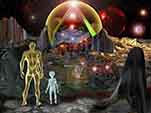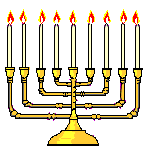The Earth may have been a very busy place before hu-man (Adam)got here. Might still be if we could see it without color or prejudice or presumption.
It may be that much of what we interpret as ancient hu-man civilization wasn't hu-man at all.
-----------------------------------------------------
Mythological water creatures.
https://en.wikipedia.org/wiki/Category:Water_spirits
-----------------------------------------------------
Flying mythological creatures
https://en.wikipedia.org/wiki/List_of_flying_mythological_creatures
-----------------------------------------------------
https://en.wikipedia.org/wiki/Jinn#Jinn_in_form_of_storms_and_shadows
Ancient Mesopotamian religion
Beliefs in entities similar to the jinn are found throughout pre-Islamic Middle Eastern cultures.[19] The ancient Sumerians believed in Pazuzu, a wind demon,[19][94]:147–148 who was shown with "a rather canine face with abnormally bulging eyes, a scaly body, a snake-headed penis, the talons of a bird and usually wings."[94]:147 The ancient Babylonians believed in utukku, a class of demons which were believed to haunt remote wildernesses, graveyards, mountains, and the sea, all locations where jinn were later thought to reside.[19] The Babylonians also believed in the Rabisu, a vampiric demon believed to leap out and attack travelers at unfrequented locations, similar to the post-Islamic ghūl,[19] a specific kind of jinn whose name is etymologically related to that of the Sumerian galla, a class of Underworld demon.[95][96]
Lamashtu, also known as Labartu, was a divine demoness said to devour human infants.[19][94]:115 Lamassu, also known as Shedu, were guardian spirits, sometimes with evil propensities.[19][94]:115–116 The Assyrians believed in the Alû, sometimes described as a wind demon residing in desolate ruins who would sneak into people's houses at night and steal their sleep.[19] In the ancient Syrian city of Palmyra, entities similar to jinn were known as ginnayê,[19] an Aramaic name which may be etymologically derived from the name of the genii from Roman mythology.[19] Like jinn among modern-day Bedouin, ginnayê were thought to resemble humans.[19] They protected caravans, cattle, and villages in the desert[19] and tutelary shrines were kept in their honor.[19] They were frequently invoked in pairs.[19]
Judaism
Shedim, one of several supernatural creatures in early Jewish mythology, resemble the Islamic concept of Jinn. Both are said to be invisible to human eyes but are subject to bodily desires, like procreating and the need to eat, and both may be malevolent or benevolent. Like the Islamic notion of jinn as Pre-Adamites, Jewish lore also regard shedim as Pre-Adamites, replaced by human beings in some legends.[97][98] Narrations regarding Asmodeus, an antagonist in the Solomon legends, appears both in Islamic lore and in the Talmud as the king either of the jinn or the shedim.[70]:120
Buddhism
Similar to the Islamic idea of spiritual entities converting to one's own religion can be found on Buddhism lore. Accordingly, Buddha preached among humans and Devas, spiritual entities who are like humans subject to the cycle of life, that resembles the Islamic notion of Jinn, who are also ontologically placed among humans in regard of their eschatological destiny.[99][100]
------------------------------------------------------
Artificial creatures
https://en.wikipedia.org/wiki/List_of_legendary_creatures_by_type#Artificial_creatures
This listing includes creatures that are man-made, mechanical or of alchemical origins.
Automaton (worldwide) – self-operating machine; most famous example is Greek mythology's Talos
Blodeuwedd (Welsh) – wife of Lleu Llaw Gyffes
Frankenstein's monster
Galatea (Greek) – ivory statue carved by Pygmalion
Gingerbread man – from German folk tales
Golem (Jewish) – animated humanoid construct
Homunculus (Alchemy) – diminutive, animated construct
Nephele (Greek) – nymph formed from a cloud by Zeus to resemble the goddess Hera
Shabti (Egyptian) – clay model used as workers
Tokeloshe (Zulu mythology) – diminutive, hairy humanoid with various magical powers
Tsukumogami (Japanese) – objects that come to life, of their own accord, after 100 years
Tulpa (Tibetan Buddhism) – creature brought to life through meditation
Tupilaq (Inuit) – large statues brought to life to serve witches and shamans
Ushabti (Egyptian) – clay guardians/assistants
Various objects animated by gods, demons and spirits in mythology, legend and folklore






































